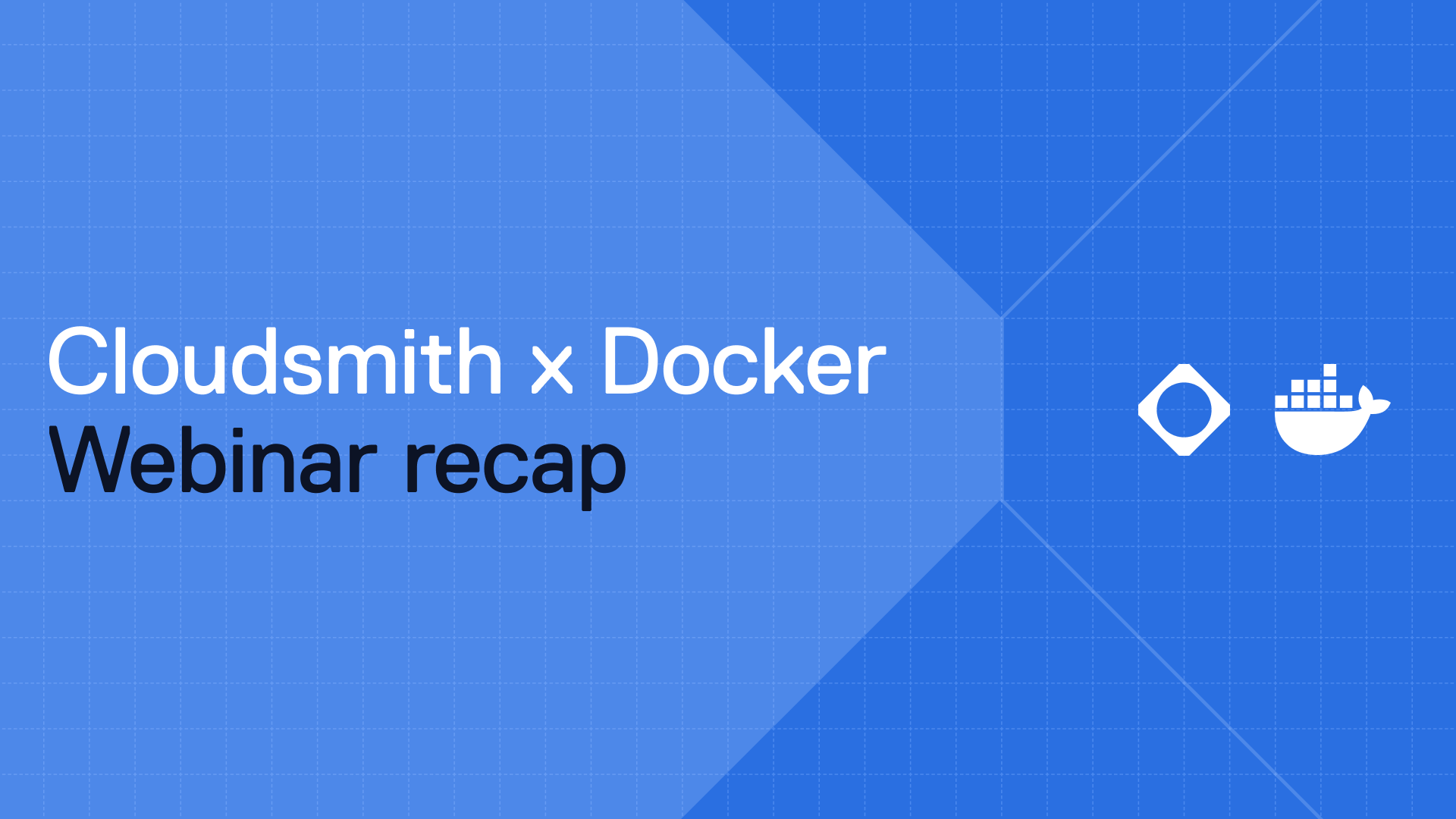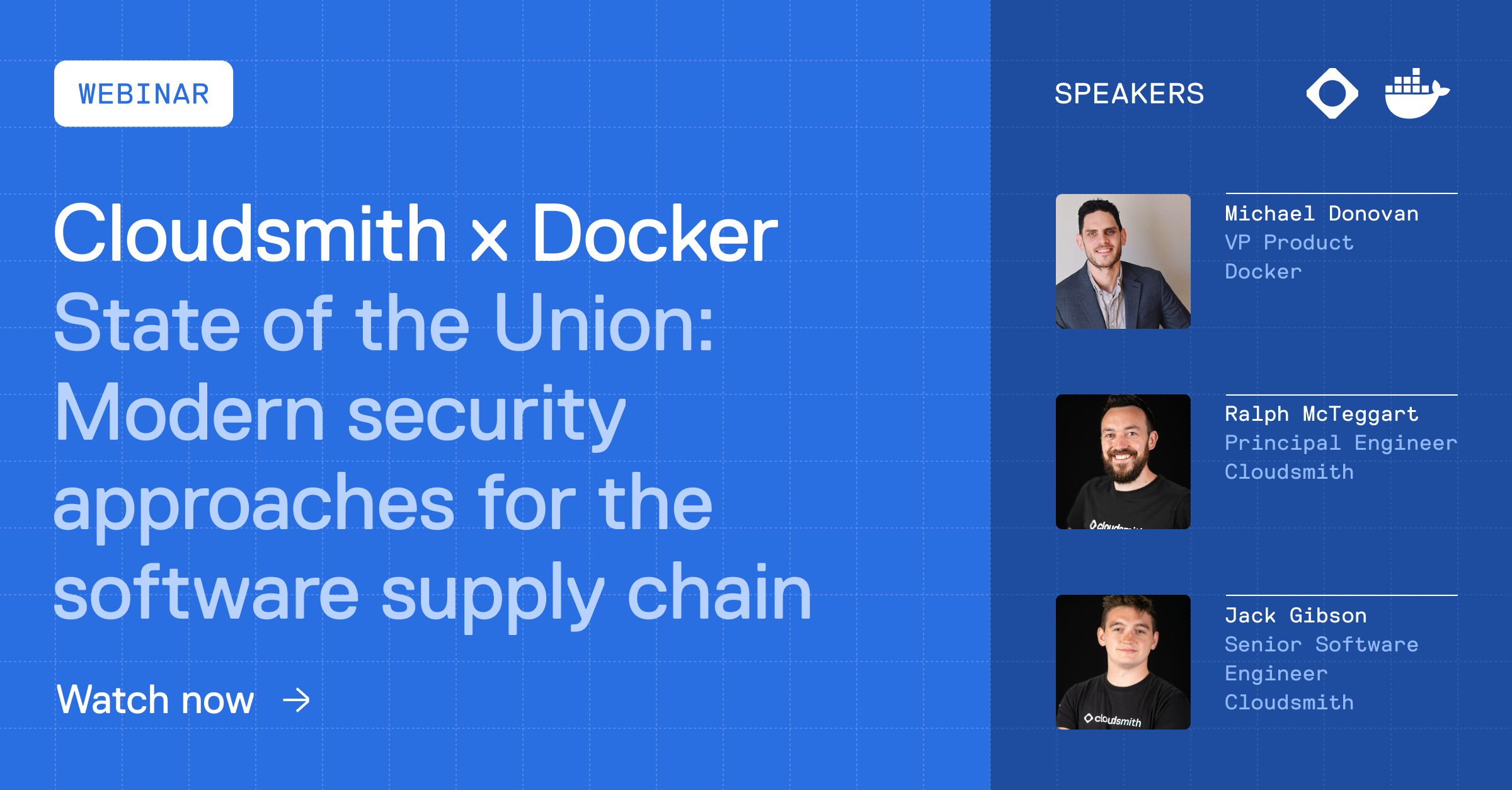Docker Hardened Images & Cloudsmith: Modern Security for the Software Supply Chain
Explore how Docker and Cloudsmith help secure the software supply chain with SBOMs, signatures, provenance, and hardened images - enabling end-to-end visibility and trust without slowing development.

This blog contains the takeaways from our webinar "State of the Union: Modern security approaches for the Software Supply Chain." Watch the full discussion here. Key topics include how to secure your CI/CD pipeline and software artifacts using SBOMs, Docker Hardened Images, and artifact lifecycle best practices.
Software supply chain attacks are on the rise, prompting a critical shift in how we secure modern software. Recent incidents like SolarWinds, XZ Utils, and Log4Shell underscore the urgent need for stronger security measures beyond just protecting production systems. Attackers are now targeting earlier stages of the supply chain, particularly build pipelines, impacting software integrity before it even reaches deployment.
In our recent webinar, "State of the Union: Modern security approaches for the Software Supply Chain," we brought together industry experts to tackle these challenges head-on. Michael Donovan, VP of Product at Docker, Ralph McTeggart, Principal Engineer at Cloudsmith, and Jack Gibson, Senior Software Engineer at Cloudsmith, shared their insights on how leading teams can defend themselves. During the session, they explored the evolving threat landscape, outlined a secure artifact lifecycle, and discussed strategies such as SBOMs to inject visibility, provenance, and trust into workflows without creating developer friction. While the focus was on container images, the principles discussed were equally applicable to other formats.
Rethinking Software Supply Chain Security
Software supply chain attacks have grown dramatically in both frequency and impact, prompting a fundamental shift in how software is secured. Incidents like SolarWinds, the XZ Utils backdoor attempt, and Log4Shell illustrate a sobering truth: attackers are now aiming upstream. Rather than targeting production systems directly, modern threats exploit vulnerabilities during the software build and integration phases, where visibility and control are often weakest.
As this attack surface expands, it’s no longer enough to harden runtime environments or secure production endpoints. The entire artifact lifecycle - from development to deployment - must be secured. This shift has led organizations to reassess their tooling, processes, and practices around software composition, packaging, and distribution.
The Shift in Emphasis on Software Supply Chain Security
The strategic focus of software security has moved upstream. Major breaches have shown how attackers exploit weaknesses in CI/CD pipelines, source code repositories, and registry infrastructure, areas traditionally outside the purview of security teams.
Events like the SolarWinds compromise in 2020, which leveraged a poisoned build system, or the 2024 XZ Utils incident, where malicious code was inserted by a fake maintainer, underscore how early-stage compromises can lead to widespread downstream impacts. Similarly, Log4Shell revealed the global exposure caused by a single vulnerable dependency, forcing organizations to redirect substantial resources just to locate and patch affected systems.
In response, governments and regulatory bodies have escalated their focus on software supply chain security (SSCS). Executive directives, such as the U.S. Cybersecurity Executive Order, FedRAMP requirements, the EU’s NIS2 directive, and the forthcoming Cyber Resilience Act, demand secure development practices, transparent artifact composition, and provable software provenance.
As attacks increasingly originate at the source, securing the artifact lifecycle is now a foundational requirement - not a future goal.
The Evolving Threat Landscape
Modern software development is built around composability and speed. Applications today rely heavily on third-party libraries and frameworks, with open-source components making up as much as 75% or more of a typical codebase. The prevalence of transitive dependencies - indirect libraries brought in through direct ones - adds complexity and opacity to risk assessment.
At the same time, the efficiency of CI/CD pipelines can leave little room for traditional gatekeeping. Code is integrated, tested, and deployed rapidly, often using packages pulled directly from public registries with minimal verification. Unsigned artifacts, missing provenance data, and outdated registry configurations persist across many organizations.
This environment creates ideal conditions for silent, hard-to-detect supply chain threats. In response, software teams must move toward practices that ensure transparency, verification, and control at every phase of the build and release cycle.
Using SBOMs and Establishing Provenance
A foundational step in securing the software supply chain is understanding exactly what is being built and shipped. This is where three elements play a critical role:
- SBOMs (Software Bills of Materials): These list all components within a software artifact - names, versions, authors, licenses, and dependency relationships. Tools such as Syft and Trivy support SBOM generation in SPDX and CycloneDX formats. Docker supports SBOMs natively through the docker sbom command. Cloudsmith accepts external SBOM uploads or can auto-generate CycloneDX SBOMs for container images, exposing them via API for automation and policy enforcement.
- Digital Signatures: A signature confirms that an artifact originated from a known and trusted source. Tools like Cosign allow developers to sign and verify containers. Signed images enable downstream consumers to confirm authenticity before deployment.
- Provenance: Provenance data describes the origin of a build, including input sources, build parameters, and environments. Docker Buildx supports automated provenance generation using the --provenance flag, capturing crucial metadata such as build arguments and platforms.
Together, these elements create an auditable trail of software origin and composition. In regulatory contexts, SBOMs are now a standard requirement. But beyond compliance, they provide security teams with the ability to trace vulnerabilities to specific packages, drastically reducing remediation time and effort. Cloudsmith’s Enterprise Policy Management (EPM) leverages SBOM metadata for automated policy actions, such as quarantining risky images or enforcing license compliance based on live dependency data
Tightening Security with Docker Hardened Images
As organizations grapple with securing sprawling software pipelines, Docker Hardened Images (DHIs) offer a straightforward way to integrate trusted, verifiable container artifacts into modern workflows, without slowing down development.
Available on Docker Hub, DHIs are a curated set of container images designed to minimize vulnerabilities out of the box. They are built with a smaller attack surface, and include a full suite of embedded security metadata by default. This makes them ideal for teams looking to adopt zero-trust practices without adding complexity or friction.
Each Docker Hardened Image ships with:
- Software Bill of Materials (SBOMs)
- Vulnerability scan results
- VEX (Vulnerability Exploitability eXchange) metadata
- Malware and secret scan outputs
- Digital signatures
- Build provenance data
These attestations provide comprehensive visibility into the contents and origin of each image. Because they are packaged directly with the artifact, they integrate seamlessly into downstream platforms like Cloudsmith or any private registry. This removes the burden of generating and attaching this metadata later in the pipeline.
The impact is significant: DHIs can reduce vulnerabilities in base images by as much as 95%, offering a hardened starting point for secure application builds. Just as importantly, they help teams meet compliance and audit requirements from day one, with verifiable transparency and traceability.
By building security directly into the image and surfacing critical metadata in machine-readable formats, Docker Hardened Images simplify the process of building secure containers—and make modern supply chain security accessible by default.
Building a Secure Artifact Lifecycle
A secure software supply chain requires continuous validation from development through delivery. This is where centralized artifact management platforms like Cloudsmith become essential.
By configuring repositories to proxy public registries (e.g., Docker Hub, NPM, PyPI), Cloudsmith performs key security checks automatically:
- Vulnerability scanning
- License and compliance verification
- Policy enforcement using EPM
Artifacts are cached and versioned, offering security and development teams full visibility and control over dependencies. When an image is pulled, verification steps - including signature checks and attestation validation - ensure that only known, trusted, and reproducible software is admitted into builds or deployments.
However, the ecosystem still faces gaps. Many widely used packages, particularly in NPM and PyPI, lack signatures or attestations. As of late 2024, only 5% of the top 360 packages on PyPI had provenance data published through the trusted publisher workflow. This makes it difficult to assert origin or integrity for many upstream dependencies.
To address this, teams should introduce a secure intermediary - like Cloudsmith - between developers and public sources. This provides enforcement points for policy, visibility into dependencies, and the opportunity to filter and block unverified packages before they can compromise the build.
Once builds are finalized, signing them and recording those signatures in transparency logs (e.g., Sigstore’s Rekor) ensures traceability and trust. This final step solidifies confidence that artifacts were not tampered with before reaching production.
Create Easy Paths to Security
Security features must be accessible, automated, and non-disruptive to gain widespread adoption. Teams are more likely to maintain best practices when secure workflows mirror familiar development patterns.
To support this, Docker Hardened Images come pre-equipped with SBOMs, digital signatures, and SLSA-compliant provenance. These attributes allow teams to build secure pipelines without requiring additional tooling or custom scripting.
When paired with Cloudsmith, this enables organizations to:
- Centrally manage and enforce policies on all artifacts
- Control access and visibility across engineering teams
- Integrate security checks without altering development velocity
The result is a zero-trust pipeline where software integrity is maintained automatically, and security is treated as a first-class concern throughout the SDLC.
Closing Thoughts
The shift towards modern security approaches is undeniable. SBOMs, signatures, and attestations are becoming fundamental elements in software development. The impending legislation, particularly in the EU with the Cyber Resilience Act, will further mandate these practices.
For a deeper dive into securing your container workflows, check out our companion blog post, "Securing Containers at Scale: Docker Hardened Images and Cloudsmith," and watch the full webinar recording.

Liked this article? Don\'t be selfish (:-), share with others: Tweet



